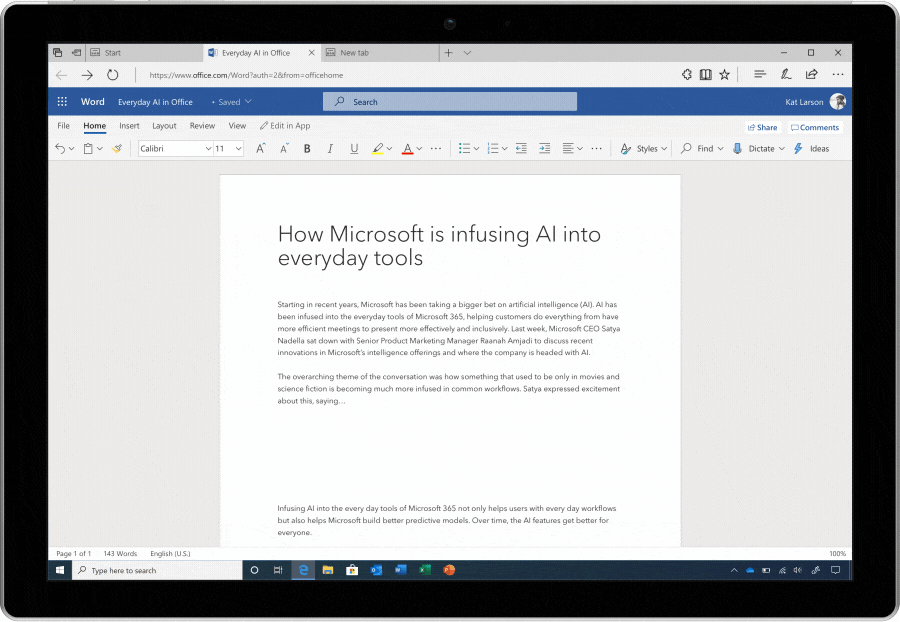Source: Microsoft
Microsoft today launched Transcribe in Word, its new transcription service for Microsoft 365 subscribers, into general availability. It’s now available in the online version of Word, with other platforms launching later. In addition, Word is also getting new dictation features, which now allow you to use your voice to format and edit your text, for example.
As the name implies, this new feature lets you transcribe conversations, both live and pre-recorded, and then edit those transcripts right inside of Word. With this, the company goes head-to-head with startups like Otter and Google’s Recorder app, though they all have their own pros and cons.
To get started with Transcribe in Word, you simply head for the dictate button in the menu bar and click on ‘transcribe.’ From there, you can record a conversation as it happens — by recording it directly through a speakerphone and your laptop’s microphone, for example — or by recording it in some other way and then uploading that file. The service accepts .mp3, .wav, .m4a and .mp4 files.
As Microsoft Principal Group PM Manager for Natural User Interface & Incubation, Dan Parish, noted in a press briefing ahead of today’s announcement, when you record a call live, the transcription actually runs in the background while you conduct your interview, for example. The team purposely decided not to show you the live transcript, though, because its user research showed that it was distracting. I admit that I like to see the live transcript in Otter and Recorder, but maybe I’m alone in that.
Like with other services, Transcribe in Word lets you click on individual paragraphs in the transcript and then listen to that at a variety of speeds. Since the automated transcript will inevitably have errors in it, that’s a must-have feature. Sadly, though, Transcribe doesn’t let you click on individual words.
One major limitation of the service right now is that if you like to record offline and then upload your files, you’ll be limited to 300 minutes, without the ability to extend this for an extra fee, for example. I know I often transcribe far more than 5 hours of interviews in any given month, so that limit seems low, especially given that Otter provides me with 6,000 minutes on its cheapest paid plan. The max length for a transcript on Otter is 4 hours while Microsoft’s only limit for is a 200MB file upload limit, with no limits on live recordings.
Another issue I noticed here is that if you mistakenly exit the tab with Word in it, the transcription process will stop and there doesn’t seem to be a way to restart it.
It also takes quite a while for the uploaded files to be transcribed. It takes roughly as long as the conversations I’ve tried to transcribe), but the results are very good — and often better than those of competing services. Transcribe for Word also does a nice job separating out the different speakers in a conversation. For privacy reasons, you must assign your own names to those — even when you regularly record the same people.
It’d be nice to get the same feature in something like OneNote, for example, and my guess is Microsoft may expand this to its note-taking app over time. To me, that’s the more natural place for it.
The new dictation features in Word now let you give commands like “bold the last sentence,” for example, and say “percentage sign” or “ampersand” if you need to add those symbols to a text (or “smiley face,” if those are the kinds of texts you write in Word).
Even if you don’t often need to transcribe text, this new feature shows how Microsoft is now using its subscription service to launch new premium features to convert free users to paying ones. I’d be surprised if tools like the Microsoft Editor (which offers more features for paying users), this transcription service, as well as some of the new AI features in the likes of Excel and PowerPoint, didn’t help to convert some users into paying ones, especially now that the company has combined Office 365 and Microsoft 365 for consumers into a single bundle. After all, just a subscription to something like Grammarly and Otter would be significantly more expensive than a Microsoft 365 subscription.



